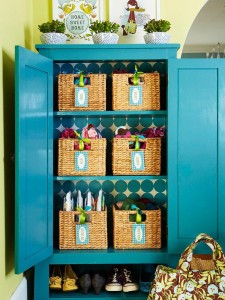Spring Cleaning and Organizing Your Family
I recently went through the messy and exhausting process of deep cleaning of my home office. I noticed that my crowded workspace was beginning to affect my mental space, so it was time to dig in and declutter. The piles on my desk were overwhelming, my bookshelves overflowing and my filing system completely ineffective. So after considerable time spent sorting, purging and reorganizing, I can say it was worth every bit of the effort. Not only is the space more inviting, the atmosphere itself feels cleaner and I feel there’s room for me and my thoughts now.
 As much as a good purging and declutter is for us as adults, it is even more significant for our kids. Young children are in the process of developing internal order and the space around them profoundly affects them externally and internally.
As much as a good purging and declutter is for us as adults, it is even more significant for our kids. Young children are in the process of developing internal order and the space around them profoundly affects them externally and internally.
Clutter outside reflects clutter inside. As kids learn to create and maintain order in their physical space, they create and maintain order internally. Order on the outside helps create order on the inside.
No matter how well you organize your child’s space, life gets busy, chaos ensues and things are going to require regular maintenance and a seasonal overhaul.
Here are some things to think about as you prepare to dig in:
All hands on deck: A deep cleaning takes team effort and may need to be done in stages. Start with your own private review of the room or area that needs organizing. Purge what you can on your own, especially those things you know need to go but will be hard for your child to part with. Then invite your child help with the rest. They can help sort things to be saved, tossed, given away and put back in place.
Keep it age appropriate: The amount of a child’s involvement depends on their age and ability to do the necessary tasks and to be able to part with things. A big cleaning can be very overwhelming, even for the adults involved, so be mindful about how much to include them. It may be best for you to do the majority of the work without them even knowing, then invite in for the finishing touches.
Respect your child’s attachments: A healthy balance is a must. Be sensitive to what your child needs to save and help them learn to release. That old shoelace or paper construction may hold special value – but perhaps there’s a toy they can pass on to a friend. Whatever it is, help them find value in the sorting and giving, without it becoming a negative or traumatic experience.
Set expectations to keep it up: Creating and maintaining organized spaces is not just about mental order and helping your child function more effectively. It’s also about establishing life long habits that will serve them well. Expect dirty clothes to get in the hamper, dishes to find their way to the sink and toys to be picked up and put away regularly. And from time to time, dig in, pull it apart and put it back together again – parental assistance required.
Photo Credit: ArtSea Chic
 |
Bette FetterFounder and CEO of Young Rembrandts and Author of Being Visual |










